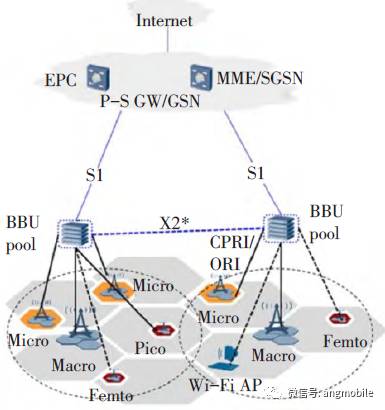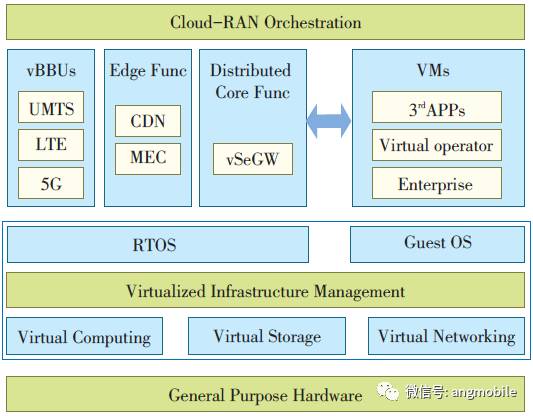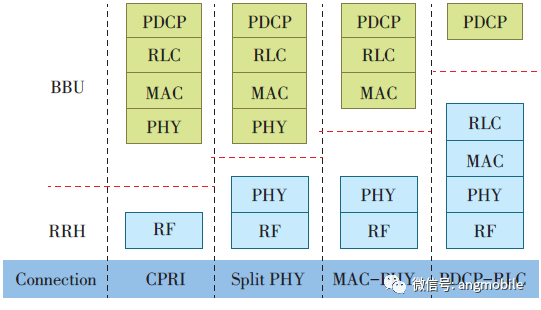

Authors
Wang Youxiang, Li Yiqun, Li Fuchang, Feng Yi: China Unicom Network Technology Research Institute.
Zhang Lan: China Xun Postal and Telecommunications Design Institute Co., Ltd.
Abstract: Using a general hardware platform, virtualization technology achieves the decoupling of software and hardware, enabling the network to have flexible scalability, openness, and evolution capabilities. By virtualizing network functions, it allows for flexible slicing and sharing of wireless resources in time, frequency, space, and power domains, forming a virtual mobile network that maximizes air interface resource utilization while providing guaranteed bandwidth based on customized needs, supporting the dynamic and low-cost network deployment requirements of the Internet of Things and virtual operators.
1
Introduction
With the continuous update of network technology, the diversification of data services, and the promotion of smart terminal applications, users have raised higher demands on the service capabilities of operators. While meeting the growing user demands, the development of the mobile communication industry faces pressures of efficiency, cost, and environmental protection. Building an efficient, economical, and sustainable high-quality mobile communication network has become the key for operators to enhance their core competitiveness. To build a low-cost quality network, operators face several challenges: firstly, the conflict between the large-scale base station construction demand and limited network investment; secondly, network construction requires a large number of sites and supporting resources, which poses a significant challenge to the quality and speed of network construction; at the same time, in response to the national call for resource conservation and environmental protection, how to effectively reduce network energy consumption and achieve energy saving and emission reduction has become an important goal for operators in network construction.
The existing base station systems based on software-defined radio partially address the operators’ need to operate multiple standards simultaneously, but they still cannot meet the future flexible operation requirements of operators in terms of directly sharing processing resources and dynamically balancing loads. Through virtualization technology, various functions of physical base stations can be implemented on a general platform, achieving wireless resource virtualization and enabling flexible slicing and sharing of wireless resources in time, frequency, space, and power domains, thereby enhancing base station processing capabilities and efficiency, significantly reducing costs, and improving system performance. At the same time, a unified hardware platform can bring many conveniences for system management, maintenance, expansion, and upgrades.
2
Evolution of Base Station Virtualization
1. Evolution of BBU Pool Architecture
Traditional wireless access networks consist of independent base stations, each connecting a fixed number of sector antennas and covering a small area. Each base station can only process the signals of its own cell, and the base stations operate independently. Through a cellular construction approach, a group of base stations can provide network coverage over a continuous area. Base stations are typically developed based on proprietary platforms, which are “vertical solutions” that hinder compatibility and upgrades between different standards. Traditional wireless access networks do not share processing capabilities, leading to low average loads, which can cause network tidal effects and unbalanced service distribution, resulting in significant waste of network resources.
As wireless communication develops, the demand for data transmission from users is increasing, and the drawbacks of traditional cellular networks in terms of construction and operation costs and energy consumption are becoming increasingly apparent. To meet user demands, future wireless network architectures need to evolve towards low energy consumption, low cost, and high efficiency. The baseband pool architecture is one of the main development directions for future wireless networks. In traditional networks, each base station requires an independent machine room, while a certain number of BBUs (tens, hundreds, or even thousands) are concentrated in a large central machine room in the baseband pool. This has obvious advantages in reducing site selection difficulties, decreasing the number of machine rooms, and sharing supporting equipment (such as air conditioning). In the baseband pool, base stations are no longer independent physical entities but rather an abstraction of part of the processing resources in the pool, with the network dynamically allocating resources based on the actual service load of each base station’s service area.
In 2013, the ETSI NFV working group released a white paper on network function virtualization (NFV) application scenarios, introducing nine different use cases, including mobile base station virtualization, and providing an example of a centralized RAN architecture for LTE as shown in Figure 1. In the white paper’s definition, base station virtualization aims to utilize IT virtualization technology to implement part or all of the RAN functions on standard IT servers, storage, and switches, enabling resource sharing, dynamic allocation, and energy consumption reduction between RAN nodes of different systems through base station virtualization.

Figure 1 Example of Centralized RAN Architecture for LTE
2. Characteristics of Base Station Virtualization
Currently, 4G networks have entered the mature commercial stage, and the R&D process for 5G networks is accelerating, while there is no clear timeline for the retirement of 2G and 3G networks. In the next 5 to 10 years, the consensus among mainstream operators is to operate multiple standards and frequency bands together. To further optimize network construction and operational costs, multi-mode base stations are widely adopted. The existing multi-mode base stations have basically addressed the operators’ need to operate multiple mobile communication standards simultaneously at the site solution level, but the base station equipment from different manufacturers is based on proprietary hardware processing platforms, and the software and hardware are tightly coupled. In terms of the openness of the base station hardware processing platform, dynamic load balancing at the network level, and energy-saving measures, it has not fully met the expectations of operators.
In June 2015, the 5G vision proposed by the ITU clearly stated the support for three major scenarios: enhanced mobile broadband (eMBB), massive low-power connectivity (eMTC), and ultra-reliable low-latency connectivity (uMTC). Different scenarios have different requirements for future 5G networks. To support rapid deployment of services and meet future differentiated and customized service needs, virtualization has become an inevitable trend in the evolution of mobile networks. By adopting a general hardware platform, cloud-based virtual base stations can dynamically schedule processing resources in a centralized baseband pool to different virtual base stations or networks of different standards based on the network load, thus effectively addressing the operators’ need for flexible operations.
Virtualized base stations should meet the following four major characteristics: generalization, abstraction, standardization, and greenness.
a) Generalization: Virtualized base stations use a unified hardware platform and can support different air interface standards through software configuration. Any changes or upgrades to the configuration of one standard’s network do not affect other standards. The relationship between the wireless standard of a truly virtualized base station and the base station itself should be similar to that between an application and a server; any application, operation, upgrade, or service withdrawal of a wireless technology does not require resetting the entire base station, while various resources of the base station can be shared among multiple wireless technologies.
b) Abstraction: The physical resources of the base station are abstracted into a virtual computing platform, which can better support multiple air interface standards, providing practical convenience for mobile operators in network management, operation, upgrades, and expansions, while protecting their original investments during network re-planning (refarming). In terms of development direction, the centralized placement of baseband processing units provides a foundation for the abstraction of virtual base stations, on which hardware device virtualization can be achieved, and multiple hardware devices can be flexibly combined to construct virtual base station entities, which is the development direction of virtualized base stations.
c) Standardization: Virtualized base stations comply with relevant international standards, featuring an open architecture and unified interfaces. The core of virtualized base stations is their architecture and interfaces, and there are no restrictions on the specific hardware used; it can be based on general processors, specialized processors, or a combination of general processors and communication co-processing units, as long as the hardware meets the corresponding industrial standards and can be packaged by upper-layer software into a unified computing module. Products that comply with standardization and industrialization for mass production can effectively reduce operators’ procurement and maintenance costs.
d) Greenness: Virtualized base stations are characterized by high performance and low energy consumption. With the explosive demand for wireless data, the use of new technologies and new frequency spectrums, and increasing site density, wireless operators are increasingly emphasizing the unit energy consumption of virtualized base stations. High performance and low energy consumption are undoubtedly the development direction of virtualized base stations.
3
Base Station Virtualization System Architecture
The future wireless network will face the coexistence of multiple standards for a long time, including 3G, 4G, 5G, and Wi-Fi access technologies in unlicensed spectrums, making the network increasingly complex. Furthermore, future mobile networks need to support various types of services, each with vastly different requirements for rate, connection numbers, latency, and other network performance indicators. To address the scalability, flexibility, controllability, and integration issues faced by heterogeneous wireless networks, a cloud architecture design based on RAN function virtualization, resource cloudification, and management elasticity is proposed to meet the differentiated functional requirements of different services and support the rapid elastic expansion and deployment capabilities of the network.
Base station virtualization adopts a generalized high-performance processing platform, abstracting hardware resources into normalized virtual resources provided for different base station function software calls (see Figure 2). The virtualized base station mainly consists of three domains: virtualized infrastructure, virtual network functions, and virtualized base station orchestrators.

Figure 2 Base Station Virtualization System Architecture
a) The virtualized infrastructure includes computing, storage, and network hardware resources along with their corresponding virtualized resources and virtual layers, supporting virtual network function calls, such as general computing devices, switches, storage devices, and also including specialized RF devices, antennas, etc.
b) Virtual network functions are the software implementations of wireless protocol functions running on top of the virtualized infrastructure, such as the logical implementation of LTE protocol stack functions, MEC, etc. Virtual network functions utilize the virtual resources provided by the virtual resource device layer to construct different virtual network functions based on images from different manufacturers. Since virtual network functions adhere to standard protocols, signaling, and interfaces, they meet interoperability requirements.
c) The virtualized base station orchestrator manages the virtualized infrastructure and virtual network functions, supporting the lifecycle management of virtualized physical/software resources and virtual network functions.
Virtualization technology modularizes the various functional modules of the network, allowing the network to schedule different functional modules based on different service requirements, enabling rapid deployment and flexible combinations of services. It also allows for rapid development, testing, and flexible deployment of new functions based on future innovations and diverse needs.
4
Key Technologies and Issues
1. Decoupling of Software and Hardware
Traditional base station equipment has tightly coupled hardware and software, with both coming from the same vendor. However, virtualized base station equipment achieves the decoupling of hardware and software, where virtual network functions and general servers often come from different manufacturers, making the compatibility of multi-vendor devices a necessary condition.
When using virtual base stations for networking, the processing resources of the base stations are encapsulated and abstracted, allowing for the construction of multiple logically complete virtual base station systems based on service demands, dynamically sharing resources, and enabling the generation and cancellation of resources as needed, thus decoupling resources and base station functions to meet the needs for dynamic resource allocation and control. For future new service deployments, the protocol stack can be dynamically configured based on service characteristics to meet differentiated service and rapid deployment needs.
2. Supporting Flexible Fronthaul Interface Design
In the ITU’s 5G vision, it is clearly stated that support for enhanced mobile broadband (eMBB), massive low-power connectivity (eMTC), and ultra-reliable low-latency connectivity (uMTC) are three major scenarios, each with different requirements for future 5G networks. These requirements can be distinguished from three performance dimensions: throughput, latency, and connection numbers. Specifically, the user experience rate for 5G can reach 100 Mbit/s to 1 Gbit/s to support mobile virtual reality and other “extreme” experiences, with peak rates reaching 10 to 20 Gbit/s; connection density can reach 1 million per square kilometer, effectively supporting massive IoT device access; and transmission latency can be as low as 1 ms, meeting the strict requirements of industrial control. Clearly, 5G networks will be more complex than existing networks, and their traffic models will become extremely complex and irregular in both spatial and temporal dimensions.
From the perspective of introducing new technologies into future 5G networks, more and more new technologies and features will emerge to enhance user bandwidth, network capacity, and service latency performance to meet the new application demands mentioned above. The 5G WeChat public platform (ID: angmobile) has learned that the author further points out that, firstly, with the increase in wireless bandwidth and the number of antennas, the transmission bandwidth between existing BBUs and RRUs has increased dramatically; secondly, in response to the upper-layer business demands for low latency and high bandwidth, there is a clear trend of business sinking and core network function edgeification. Considering the business hit rate, sinking the business to the centralized BBU deployment room is a compromise choice for business hit rate and latency requirements. In this case, a high-bandwidth, low-latency fronthaul network is the foundation for meeting upper-layer business demands.
Therefore, virtualized base stations can flexibly partition the functions of baseband processing resources based on actual fronthaul transmission conditions, i.e., redefining the functional partitioning between BBUs and RRUs, and the interfaces between relevant BBUs and RRUs also need to be redesigned. Figure 3 shows four different functional partitioning schemes.

Figure 3 BBU Functional Partitioning
3. Elastic Wireless Resource Management
Future different application scenarios will have varying requirements for wireless network throughput, latency, user connection numbers, and reliability. Based on virtualization, the future communication network can be vertically divided into a unified underlying infrastructure platform, a virtual resource pool, and a service network domain. The virtual resource pool can achieve unified management, allocation, deployment, and monitoring of network resources, allowing the entire network to dynamically scale virtual network functions based on load conditions, which is the foundation for achieving dynamic control and intelligent networking.
Virtualized base stations can provide differentiated services for different users and applications, ensuring user performance. The virtualized data plane deploys virtual functional network elements based on service characteristics and traffic distribution, and then maps physical resources to the logical data plane topology. Resource mapping includes transmission resources and wireless resources, with the wireless network managing and scheduling transmission resources and wireless resources in real-time. Elastic wireless resource management technology can dynamically balance complex resources among physical resources, deploying processing functions as needed, achieving unified management and flexible scheduling of network resources.
4. Hardware Capability Requirements
Base stations need to have strong signal processing capabilities to ensure real-time processing, especially for physical layers that require extensive signal processing calculations. When using virtualization technology for baseband processing, high-performance general processors or specialized acceleration hardware must be used to achieve real-time processing virtualization, ensuring that signal processing capability requirements are met. Virtual base stations have an open architecture, whether based on general processors or using a combination of general processors and signal acceleration processing units, they must comply with relevant industrial standards and provide unified, shared standard interfaces for NFV-related software to be deployed on hardware devices.
5
Conclusion
Wireless networks build a cloud architecture that meets real-time requirements and high reliability through the pooling and virtualization of base stations, as well as the integration of wireless technology and IT. Wireless networks utilize IT technology to create an open cloud architecture platform based on communication systems, which can help operators reduce hardware costs and improve resource utilization compared to traditional proprietary processing system architectures, while better supporting future new standards and services, and meeting the requirements for capability openness.
LikeFollow us ↓↓↓For more information, please follow us→We are the leading new media platform focusing on 5G mobile communications: ① The latest status and trends of 5G standards, policies, spectrum, technology, products, IoT, services, and markets; ② Two-way wireless networks for broadcasting. LikeShare this article!For more information, please follow us→
LikeShare this article!For more information, please follow us→